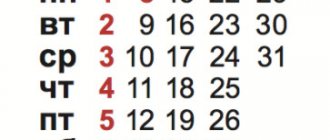How is summarized working time recording used?
19551 Contents of the page Remember, SURV stands for summarized accounting of working time. There are organizations with such peculiarities of labor organization that do not allow establishing daily or weekly working hours, for example, seasonal production.
But the employer is obliged to regularly count hours worked in any case.
For such enterprises, the Labor Code of the Russian Federation provides for a special accounting regime - summarized. No matter how labor hours are distributed over the course of a week, ten days, month, quarter, their total number for an accounting period that does not exceed a year must comply with the standards established by law. Let's consider the nuances regarding the schedule of such accounting, and also analyze how it will be implemented during a shift work schedule.
Let us touch upon the issues of calculating remuneration for labor using this accounting method, including in situations where there was overtime.
Let us show how working hours are calculated when summing up using a specific example.
Summarized accounting is, in essence, a special operating mode based on compliance with certain schedules (usually “” or). The basis for establishing such schedules is the reason “by contradiction” - when it is not possible to plan the regime in such a way that the working week is the fixed number of hours provided for by the norms of Art.
91-92 Labor Code of the Russian Federation:
- 35 – for those with a disability group;
- 39 – for doctors
- 40 hours is the standard duration.
- 24 – for youth under 16 years of age;
- 36 – for teachers and workers in hazardous industries;
A working week cannot include more than 40 hours.
With RMS, shortcomings during one period can be compensated by processing in other time intervals, which in total reaches the result required by the standard. When introducing an RMS system at an enterprise, a work schedule is a mandatory document.
FOR YOUR INFORMATION! Art. 103 of the Labor Code of the Russian Federation clearly requires the drawing up of an RMS schedule only for an operating mode that includes shifts.
Summarized recording of working time: how to take into account employee vacations when calculating standard hours?
Question In a company, the summarized accounting of working hours is a yearly accounting period. They work 2/2 for 12 hours.
- Should annual paid leave be taken into account when calculating standard hours?
If an employee goes on vacation, is it necessary to subtract the number of vacation hours from his standard hours?
But then he will have a “defect”, should we pay for it? If an employee takes days without pay, he also has a shortfall. In this case, do we pay it according to the average?
Answer
The standard working time of an employee who is absent for a valid reason provided for by law (any vacation, sick leave) is reduced by the hours of absence compared to the standard working time according to the production calendar. Hours of absence for a valid reason should not be worked out in the future. In the situation under consideration, the employee’s being on leave (annual, without pay) is not a defect. Average earnings for these periods of absence from work are not paid. Justification According to Art. 104 of the Labor Code of the Russian Federation, when, due to the conditions of production (work) for an individual entrepreneur, in the organization as a whole, or when performing certain types of work, the established for this category of workers cannot be observed (including workers engaged in work with harmful and (or) dangerous working conditions ) daily or weekly working time, it is allowed to introduce summarized working time recording so that the working time for the accounting period (month, quarter and other periods) does not exceed the normal number of working hours.
The accounting period cannot exceed one year, and for recording the working time of workers engaged in work with harmful and (or) dangerous working conditions - three months.
According to Art. 155 of the Labor Code of the Russian Federation, the employer is obliged to ensure that the employee works the total number of working hours during the accounting period.
What is the procedure for calculating vacation during a shift work schedule?
According to the Labor Code of the Republic of Kazakhstan, summarized accounting of working time is accounting of working time by summing it up for the accounting period
.
According to Article 75 of the Labor Code of the Republic of Kazakhstan, summarized recording of working time
is used in continuously operating production facilities, workshops, sections and in certain types of work where, due to production (work) conditions, the daily or weekly working hours established for this category of workers cannot be observed.
The accounting period for the summary recording of working time is the period within which the average daily and (or) weekly working hours established for a given category of employees must be observed. At the same time, the accounting period can be any calendar period, but not more than one year or the period of performing certain work, approved by the employer’s act.
When establishing a summarized accounting of working time, it is mandatory to observe the duration of the employee’s rest between the end of work and its start on the next working day (work shift), which cannot be less than 12 hours.
According to Article 68 of the Labor Code of the Republic of Kazakhstan, normal working hours should not exceed 40 hours per week.
According to Article 78 of the Labor Code of the Republic of Kazakhstan, overtime work should not exceed
for each employee
2 hours per day
, and for heavy work, work with harmful and (or) dangerous working conditions - 1 hour.
At the same time, the total duration of overtime work should not exceed 12 hours per month and 120 hours per year
.
The employer is required to record the actual time worked and unworked by the employee, while the time of overtime work, night work, weekends, holidays, and business trip days are taken into account separately.
In case of piecework wages, additional payment for overtime work is made in the amount of not less than 50% of the established daily (hourly) rate
employee. By agreement of the parties, hours of rest may be provided for overtime work at the rate of at least one hour of rest per hour of overtime work.
According to Article 90 of the Labor Code of the Republic of Kazakhstan, the duration of paid annual labor leave is calculated in calendar days, excluding holidays falling on the days of paid annual labor leave, regardless of the applied working hours and shift schedules.
According to Article 106 of the Labor Code of the Republic of Kazakhstan, remuneration for summarized accounting of working hours is made for the number of working hours actually worked according to the shift schedule. At the same time, wages are calculated at an hourly tariff rate, calculated on the basis of the tariff rate (official salary) and the monthly standard of working time in accordance with the balance of working time for the corresponding calendar year.
According to the Unified Rules for Calculating Average Wages, approved by Order of the Minister of Health and Social Development of the Republic of Kazakhstan dated November 30, 2015 No. 908, both for a five-day and a six-day working week, it is paid for the actual time worked based on the average daily (hourly) earnings for the corresponding period taking into account established additional payments and allowances, bonuses and other incentive payments of a permanent nature, provided for by the remuneration system.
When calculating the average salary, payments that are not of a permanent nature, specified in the appendix to the rules, are not taken into account.
Thus, to calculate vacation pay for a shift work schedule, it is necessary to divide the amount of the employee’s accrued income for the billing period, taking into account night, holiday and other payments (of a permanent nature), by the number of hours actually worked in the billing period. If the billing period has not been fully worked, then the average daily (hourly) earnings are determined by dividing the amount of accrued wages for the time worked by the number of working days (hours) in a five-day or six-day working week, respectively, falling on this time worked.
Then it is necessary to calculate the number of working hours during the period of labor leave according to the employee’s individual work schedule. The average salary of an employee is calculated by multiplying the average hourly earnings by the number of working hours during the event period according to the employee’s approved shift schedule.
At the same time, when calculating wages, the balance of working hours approved by the Ministry of Labor and Social Protection of the Population of the Republic of Kazakhstan for the corresponding calendar year is used.
Is vacation taken into account in the work schedule with summarized working hours?
Answer to 1 question: Should the schedule take into account annual vacations? If so, how to reflect the transfer of vacation?
You are not required to indicate the employee’s vacation in the work (shift) schedule; moreover, it is not recommended to do this. An employee's vacation is determined not by his work schedule, but by the vacation schedule ().
In addition, in a number of situations, vacation time can be transferred to another period in whole or in part, for example, in case of illness. If you indicate vacation in the shift schedule, then in the future it will have to be reissued if the procedure for using vacation changes. Taking into account the above, it is possible to reflect vacation in the shift schedule if there is such a need, but it is not recommended.
Answer to question 2: If the schedule was initially drawn up without taking into account vacation based on the standard hours, then when calculating overtime, is it also necessary to subtract annual leave time from the standard? Yes need. When calculating the standard working time for a specific employee, it is necessary to exclude periods when the employee did not work, but he retained his place of work (time of illness, vacations, etc.).
d.). Answer to question 3: How can you avoid overtime when creating a work schedule? It is advisable to draw up a work schedule (shift) for the entire accounting period, so that within this accounting period the employee works the required hours, without overtime or shortcomings.
To create a correct schedule, taking into account the number of employees, the volume of work performed and the total number of shifts per day, distribute the shifts and.
Determine the number of working days (shifts) during the accounting period. Then calculate the total number of hours for each employee's shifts in the accounting period. Compare the result obtained with the standard working hours for the accounting period.
Taking into account the comparison, adjust the schedule in terms of shift duration and frequency (if necessary). Note: standard working hours for 2015
really is 1971 hours, this corresponds to the production calendar, compiled taking into account all the transfers of weekends, and is not an excess.
How to calculate overtime taking into account vacation?
Dmitry Question asked February 17, 2021 at 12:33 pm Hello.
I work in the police department and encountered this situation. With a work schedule, day-night-two at home, in January 2021 I actually worked 149 hours, and since January 25 I went on vacation.
When calculating overtime, our personnel employees subtracted the standard hours for January 136 from 149 hours, as if I had worked a full month.
Should the staff have reduced the standard hours for the period I was on vacation, and what documents are this regulated?
Thanks in advance for your answer. The question relates to the city of Tver Lyubov_ Published February 17, 2021 at 2:47 pm Published February 17, 2021 at 2:47 pm Hello! Summarized working time accounting is based on working time standards calculated for certain periods (month, quarter, etc.).
etc., but not more than for a calendar year), called an accounting period, based on the normal (or reduced) working hours.
The standard working time for the accounting period is calculated according to the rules based on the generally established norm, for example, 40 hours per week. The procedure for calculating the standard working time for certain calendar periods of time (month, quarter, year) depending on the established duration of working time per week, approved.
By Order of the Ministry of Health and Social Development of the Russian Federation of August 13, 2009 N 588n. In accordance with Article 91 of the Labor Code of the Russian Federation, the Procedure for calculating the norm of working time for certain calendar periods of time (month, quarter, year) has been approved, depending on the established duration of working time per week.
The procedure for calculating the standard working time for certain calendar periods of time (month, quarter, year) depending on the established length of working time per week.
The standard working time for certain calendar periods of time is calculated according to the calculated schedule of a five-day work week with two days off on Saturday and Sunday, based on the duration of daily work (shift):
How are vacation hours taken into account when totaling time?
quoted1 > > Consequently, the standard working time in these cases should be reduced by the number of hours missed by the employee according to his work schedule.
However, current legislation does not define this situation as a deficiency and does not oblige the employer to pay for this period according to the average.
In addition, since the employee was absent from work for certain reasons provided for by law (in the situation under consideration, vacation), these periods of absence are paid in accordance with current legislation (vacation pay has already been paid for vacation).
The legislation does not provide for double payment for one period, i.e. one period is not paid twice (vacation pay and average earnings).
Thus: The standard working time of an employee absent for a valid reason, provided for by law (any vacation, sick leave), is reduced by hours of absence compared to the standard working time according to the production calendar. Hours of absence for a valid reason should not be worked out in the future.
In the situation under consideration, the employee’s being on leave (annual, without pay) is not a defect. Average earnings for these periods of absence are not paid. The question was answered by: I.V. When paying an hourly wage, the tariff part of the salary depends on the number of hours worked and is determined by multiplying the hourly tariff rate by the number of hours actually worked in the current month.
Calculation of vacation pay for an employee with summarized recording of working time The employee has a summarized recording of working time with an accounting period of a quarter. His salary is calculated based on the time actually worked. The employee is granted labor leave for 25 calendar days from July 6.
He worked 12 full months preceding the month of leave.
Info The employee's salary at the time of accrual of vacation pay is RUB 6,000,000. For the period from July 2014
How to determine average earnings for calculating vacation pay
When calculating the average daily earnings to determine the amount of vacation pay, all income received by employees during the billing period is taken into account, namely:
- salary;
- allowances;
- additional payments for processing;
- awards, bonuses;
- material aid;
- other payments for labor achievements.
In general, the average daily salary for vacation pay is calculated using the formula:
AvgDnZ = AvgYdZ: 12 months. : 29.3 ,
where SrGodZ is the total amount of income for the billing period; 29.3 is a fixed indicator of the average monthly number of calendar days.
The above formula for calculating vacation pay is applied in cases where the employee has worked the entire pay period in full. If during the billing period the employee was on sick leave, on vacation at his own expense, or was absent from work due to downtime, then such periods are excluded from the billing period, and payments accrued for the excluded period are not taken into account in calculating average earnings.
Based on the Labor Code of the Russian Federation, the following are excluded from the billing period:
- vacation at your own expense;
- sick leave for pregnancy and childbirth;
- a period of temporary incapacity for work issued on the basis of a sick leave certificate;
- time to care for a disabled child;
- a day of rest given to the donor;
The formula for calculating average daily earnings with excluded periods is as follows:
AverageDnZwith excluded periods = YearDoh : (NumberMonth * 29.3 + 29.3 : (DnMonth *DnPr)),
where GodDoh is the employee’s annual income for the billing period; NumberMons – the number of months during the year that the employee worked in full; DnMes – the total number of calendar days in a month with an excluded period; DnPr – the number of calendar days in a month minus the excluded period.
Vacation with summarized recording of working hours
An enterprise whose product output requires continuity of the production process switches to a shift work schedule using.
The duration of the time period under consideration is twelve months:
- When drawing up the work schedule, management took into account the standard working hours.
- The standard working time for 12 months is 1986 hours.
- The production will operate in four shifts.
- Employees are notified by signature that they will work according to the new schedule.
At the end of the twelve-month working period, it was time for the employees to take vacations. The Labor Code regulates work on summarized accounting (Labor Code of the Russian Federation), namely, it prohibits exceeding the normal amount of working time for the period under consideration (month, quarter, year).
The normal working hours are assigned to employees by the Labor Code of the Russian Federation, based on the categories to which they belong. For certain categories of workers, the standard working hours differs: for example, a miner (who works in particularly dangerous conditions) and a seamstress. Any work schedule is guided by the fact that the duration of the labor process per working week cannot exceed 40 hours.
The order of the Ministry of Health and Social Development of Russia dated August 13, 2009 determines working hours:
- Like a five-day week with an eight-hour working day and two days off (Saturday and Sunday).
- It is prohibited to work for two shifts in a row (Labor Code of the Russian Federation).
- Shifts at night are reduced by 1 hour (Labor Code of the Russian Federation).
- The work shift on the day before the holiday is also reduced by an hour (Labor Code of the Russian Federation).
- One shift can last up to 12 hours.
- The lunch break does not count towards working hours (from 30 minutes to two hours).
- The working day on pre-holiday days is seven hours.
The Labor Code of the Russian Federation guarantees employees annual leave, during which the employee retains his job and is paid an average salary. The Labor Code provides for the procedure by which citizens receive vacations.
Does vacation count towards working hours?
It is clear that under any working regime, a worker cannot work the hours that he was on legal leave. Accordingly, the norm of working hours for the year for an employee will be less by the number of hours that fell on any type of leave (annual, educational, at one’s own expense, sick leave or leave taken to fulfill civic duty). Vacation time during working hours must be deducted from the employee's total vacation period.
That is, the standard working hours for a certain period are initially determined without subtracting missed working days. Next, the total number of working hours attributable to vacation is subtracted from this standard. The Labor Code does not prohibit employers from drawing up shift work schedules taking into account all types of employee leave. Moreover, these vacations are planned in advance and their time frames are known.
The Labor Code does not prohibit employers from drawing up shift work schedules taking into account all types of employee leave.
Upon careful study of Art. 123 of the Labor Code of the Russian Federation, it becomes clear that a vacation schedule for an enterprise can be formed and signed long before the two-week limit at the end of the year. This will help the organization’s management to combine the vacation schedule with a shift work schedule, which means it is possible to reduce the accounting working time in the shift schedule during the employee’s vacation.
How to properly keep track of working hours: 5 basic rules
Advanced training OSNO. USN. Personnel. Salary. Training at Kontur.School According to Art.
104 of the Labor Code of the Russian Federation, when, due to the conditions of production (work) when performing certain types of work, the daily or weekly working hours established for this category of workers (including workers engaged in work with harmful and (or) dangerous working conditions) cannot be observed, it is allowed introduction of summarized working time recording.
Summarized working time accounting must be entered if:
- 24/7 work;
- when working on a rotational basis - in this case, the introduction of summarized accounting is mandatory.
- there are employees who have flexible working hours;
- The organization uses inter-shift work;
For some employees, summary recording of working time is established on the basis of regulatory legal acts of executive authorities.
This applies to both organizations and individual entrepreneurs. Summarized accounting is introduced both for the organization as a whole and for certain categories of employees. For example, conductors, sellers, security guards and other categories of workers.
For example, for car drivers, if it is impossible to comply with the norms of daily (weekly) working hours, summarized accounting is established with an accounting period of a month (clause 8 of Order of the Ministry of Transport of Russia dated August 20, 2004 No. 15).
We recommend the webinar Expert Evgenia Konyukhova has prepared for you a selection of the necessary regulatory documents; the manual contains a summary of current issues on personnel records management. It is allowed to introduce summarized recording of working hours so that the duration of working hours for the accounting period (month, quarter and other periods) does not exceed the normal number of working hours (Art.
140 Labor Code of the Russian Federation). The accounting period cannot exceed one year, and for recording the working time of workers engaged in work with harmful and (or) dangerous working conditions - three months.
In general, the accounting period can be: one month, two months, three months, etc.
Vacation with summarized recording of working hours
Working time is the period during which an employee must engage in labor duties, following internal regulations and the terms of the employment contract (Article 91.1 of the Labor Code of the Russian Federation). And the employer is obliged to record the time actually worked by the employee.
Often, an organization needs to set a special schedule for employees and tie wages to it; for this, summarized working time tracking is used. Working time can be counted in different ways, depending on the specifics of the job.
The main goal of different methods of recording working time is to ensure the normal length of the working week (month, year). To do this, working time is taken into account: daily, weekly or cumulatively.
In case of daily accounting, it is assumed that the duration of the daily shift is the same.
The most common option: 8 hours of work per day for a 40-hour work week.
Then work in excess of this norm is recognized as overtime in any case, even if the employee thus tries to compensate for the shortfall of the previous day.
When accounting on a weekly basis, it is important to maintain the working hours during the week.
The usual option is a 40-hour work week; for some categories of employees a shorter work week is established. On different days of the week, an employee can work a different number of hours, but in total the weekly norm must be observed. Weekly accounting is suitable for flexible schedules or shift work.
Summarized accounting is introduced when necessary for production purposes:
- in multi-shift mode;
- if the work is organized on a rotation basis;
- with a flexible schedule;
- when working around the clock.
Summary accounting can be entered for the entire organization or for some employees, as well as for certain types of work.
The rules for introducing summarized accounting are prescribed in Art.
104 Labor Code of the Russian Federation. If an enterprise introduces summarized recording of working hours, then a special work schedule is introduced for this purpose.
First of all, the period within which working time will be taken into account is established.
Do the hours an employee spends on unpaid leave reduce the standard working hours?
Answer to the question: Yes, they reduce it.
When calculating the standard working time for a specific employee, it is necessary to exclude periods when the employee did not work, but he retained his place of work (time of illness, vacations, etc.).
d.). During unpaid leave, the employee retains his place of work, therefore, this period must be excluded from the standard hours. Note: in the situation under consideration, the employee was transferred to cumulative accounting in the middle of the accounting period, and not from the beginning. Therefore, for him, the standard working time should be calculated not for the entire accounting period, but from the date of transfer to shift work and summarized accounting until the end of the accounting period: from 08/01/2014.
to 12/31/2014. The standard hours worked by him during this period must be compared with the standard hours for the same period according to the production calendar, excluding vacation periods (both paid and unpaid). Details in the System materials: 1.
Answer: How to calculate the standard working time for an employee who quits before the end of the accounting period Nina Kovyazina, Deputy Director of the Department of Education and Human Resources of the Ministry of Health of Russia If an employee quits before the end of the accounting period, then the standard working time for him is calculated from the beginning of the accounting period until the day of dismissal .* This conclusion follows from the totality of articles of the Labor Code of the Russian Federation.
Thus, if an employee is dismissed before the end of the accounting period, the hours worked overtime by him are counted not at the end of the accounting period, but from the beginning of the accounting period until the day of dismissal. For example, if the standard working time (according to the production calendar) from the beginning of the accounting period until the day of dismissal was 446 hours, and the employee actually worked 460 hours during this period, then the duration of overtime work will be 14 hours. Their payment must be made to ().
There may be cases when an employee worked less than normal during the accounting period. Payment in this case depends on whose fault the defect occurred.
Total accounting of working time - calculation examples
> > August 21, 2021 Summary recording of working time (the exact term in the Labor Code is “summary recording of working time”) is used in cases where, due to objective reasons, the normal length of the working week is not observed, for example, during shift work. The nuances of calculating time worked and the principles of calculating wages when using summarized accounting are discussed in the article. The legislator normalizes the duration of an employee’s work.
The main criteria are (1) the amount of working time for (2) the established time interval. The Labor Code generally defines the normal duration of work, which is also the maximum, as a 40-hour work week (Art.
90). The employer is obliged to take into account the working time of employees personally, separately recording the actually worked hours of each person in the time sheet. For the form for recording working hours and the procedure for filling it out, see. As is known, a significant number of organizations use a work schedule whose daily duration goes beyond the traditional 8-hour work day.
These are organizations engaged in serving the population (medical, trade, service sector, transport, etc.), or producing products with a long production cycle. The concept of “long production cycle” means that the technological length of the production process is greater than the standard length of working time regulated by law.
To ensure the maintenance and production process in such cases, the employer introduces. Often, with this regime, it is impossible to maintain the established, standardized duration of weekly or daily work.
For example, one week workers have overtime, and the next week they have free time.
With normal accounting of working time, overtime should. But to prevent this from happening, the legislator allows the employer to use summarized recording of working hours (Article 104)
Is vacation time included in working hours?
Natalya Question asked February 27, 2021 at 12:00 Is vacation time included in working hours?
Thus, in 2021, the standard working time with a 5-day working week was 1974 hours. Is vacation calculated from this number of hours? And if it is calculated, then how much.
We have a vacation of 28 days. The question relates to the city of Kemerovo Love_ Published on February 27, 2021 at 1:37 pm Published on February 27, 2021 at 1:37 pm Hello! No, vacation is excluded from the working time norm. Question: About the procedure for reducing the norm of working hours that must be worked in the accounting period by the number of hours during which the employee was released from performing labor duties while maintaining his job.
Answer: FEDERAL SERVICE FOR LABOR AND EMPLOYMENT LETTER dated March 1, 2010 No. 550-6-1 The Legal Department of the Federal Service for Labor and Employment reviewed the application. We report the following. According to Art.
104 of the Labor Code of the Russian Federation, when, due to the conditions of production (work) for an individual entrepreneur, in the organization as a whole, or when performing certain types of work, the daily or weekly working hours established for a given category of workers cannot be observed, it is allowed to introduce summarized recording of working hours, so that the duration of working hours for the accounting period (month, quarter and other periods) does not exceed the normal number of working hours. The normal number of working hours for the accounting period is determined based on the weekly working hours established for this category of workers. When calculating the norm of working hours that must be worked in the accounting period, the time during which the employee was released from work duties while maintaining his job (in particular, annual leave, study leave, leave without pay, temporary disability) is excluded from this period. , the period of fulfillment of state and public duties).
From a letter to the editor:
“An employee of our organization, who has a summarized recording of working time with an accounting period of a quarter, wrote an application to be granted 14 calendar days of labor leave from April 26, 2021.
Work of employees with summarized accounting of working hours is paid on the basis of the tariff salary. Additional payment for overtime is made in the last month of the quarter.
How to correctly include additional payment in the calculation of vacation pay?
Sincerely, accountant Ekaterina Nikolaevna"
During the labor leave, the average earnings are maintained, which is calculated by multiplying the average daily earnings by the number of calendar days of vacation.
Average daily earnings are determined by dividing the wages actually accrued to the employee for the months taken to calculate average earnings by the number of these months and by the average monthly number of calendar days equal to 29.7 (clause 5 of the Instructions on the procedure for calculating average earnings retained in the cases provided for legislation approved by Resolution of the Ministry of Labor of the Republic of Belarus dated April 10, 2000 No. 47; hereinafter referred to as Instruction No. 47).
Let us dwell on the features of calculating wages to employees with summarized accounting of working hours.
Remuneration of employees with summarized accounting of working hours
The work of employees with a summarized accounting of working hours is paid on the basis of hourly and (or) monthly tariff rates (salaries), which are determined in a collective agreement, agreement or by the employer (part one of Article 161 of the Labor Code of the Republic of Belarus; hereinafter referred to as the Labor Code). When recording working hours in aggregate, workers often have overtime, i.e. working overtime. Overtime is defined as the difference between the actual time worked according to the working time sheet and the standard working time established by the work schedule for the accounting period. The duration of the accounting period is set by the employer, but it cannot exceed one year. The accounting period can be determined by calendar periods (month, quarter), other periods (part five of Article 126 of the Labor Code). At the end of the accounting period, employees are paid overtime.
In addition to overtime, when recording working hours in aggregate, employees often work at night, on holidays and public holidays, which are working days according to the work schedule.
Let us remind you how overtime and night time, as well as work on holidays and public holidays, are paid.
For employees paid on a time basis, for each hour of work overtime, on public holidays, public holidays and weekends, in addition to the wages accrued for the specified time, an additional payment is made in an amount not lower than hourly tariff rates. The employer sets the specific amount of compensation for overtime work independently; only the lower limit of additional payment is determined by law (Article 69 of the Labor Code).
Additional payment for work at night is made in the amount of not less than 20% of the hourly tariff rate (Article 70 of the Labor Code). The specific amount of the surcharge is set by the employer.
For each hour of work on public holidays, public holidays and weekends in excess of the wages accrued for the specified time, employees with time wages are paid an additional payment not lower than the hourly tariff rates (salaries) (part one of Article 69 of the Labor Code).
When calculating the hourly tariff rate, you can apply clause 6 of the Explanation on the procedure for determining the estimated standard of working time and the hourly tariff rate in the Republic of Belarus, approved by Resolution of the Ministry of Labor of the Republic of Belarus dated October 18, 1999 No. 133 (hereinafter referred to as Explanations No. 133). Thus, hourly tariff rates are determined by dividing the monthly tariff rate (salary) by the average monthly number of estimated working hours. In this case, the average monthly number of estimated working hours used in calculating the hourly tariff rate is determined by dividing the corresponding annual estimated working hours by 12 months (part one, clause 7 of Explanation No. 133).
To pay employees of commercial organizations, the employer determines the hourly wage rate independently. The corresponding procedure is established in the local regulatory act of this organization (part one of Article 63 of the Labor Code).
Thus, to calculate the hourly tariff rate for remuneration of employees of commercial organizations, the employer can apply the average monthly standard of working time, calculated both in the manner determined by Explanation No. 133, and independently, enshrining the procedure in a local regulatory legal act.
Including additional payments to calculate average daily earnings
Obviously, your question, Ekaterina Nikolaevna, is how additional payments for overtime and night time, for work on holidays and public holidays are included in the calculation.
To understand this, let us turn to the List of payments taken into account when calculating average earnings, which is an appendix to Instruction No. 47 (hereinafter referred to as List No. 47).
Compensatory payments related to work hours and working conditions that are included in the calculation of average daily earnings include:
– additional payments for work at night (subclause 3.2, clause 3 of List No. 47);
– payment for work on public holidays and public holidays, as well as for work overtime (subclause 3.5, clause 3 of List No. 47).
Important! Instruction No. 47 does not establish the specifics of including these payments when calculating vacation pay. Therefore, such payments are included in the full accrued amount in the earnings of the month in which they fall according to the personal account.
To calculate the average daily earnings of an employee, earnings for the 12 calendar months preceding the month the vacation begins are taken (clause 4 of Instruction No. 47). Incomplete months in which the employee was released in accordance with the law from his main job with partial or no pay are excluded from the 12-month period. At the same time, if in such months the employee’s earnings were higher or at the level of full months of the billing period, incomplete months are not excluded (clause 13 of Instruction No. 47).
Let's consider the calculation of vacation pay for a specific situation.
Situation. Calculation of vacation pay for an employee with accumulated working hours
The employee is provided with a summarized recording of working time with an accounting period of a quarter. He is granted labor leave for 14 calendar days from April 26, 2021. The employee has worked for the full 12 months preceding the month the leave was granted.
Data on the employee's salary are presented in table. 1.
Salary is calculated on the basis of monthly salary. For the period from July 1 to December 31, 2021, the employee’s monthly salary was 480.00 rubles, from January 1, 2021 - 500.00 rubles.
In February 2021, the employee was awarded a bonus based on work results for 2021 in the amount of a monthly salary of 500.00 rubles.
In January 2021, the employee was on social leave for family reasons for 3 days.
In June 2021, the employee worked 2 working days according to the schedule, and from June 6 to June 30 was on labor leave for 25 calendar days. The amount of vacation pay was 432.48 rubles. In accordance with the collective agreement, the employee was paid a one-time payment for health improvement when granted labor leave in the amount of 200 rubles.
In May 2021, the employee was on sick leave for 5 days. The amount of temporary disability benefits is 64.58 rubles.
When calculating average daily earnings, the following must be taken into account.
1. Two months are excluded from the calculation, since the employee was released from work and his earnings turned out to be less than in the months fully worked:
– in January 2021 – leave without pay;
– in May 2021 – temporary disability.
Thus, the period adopted for calculating average daily earnings is 10 months.
2. In February 2021, the employee was awarded a bonus based on work results for the year in the amount of RUB 500.00.
The bonus accrued in February 2021 is included in the calculation of vacation pay in proportion to the months taken for calculation in relation to the entire calculation period, i.e. The calculation includes a bonus based on the results of work for the year in the amount of 416.67 rubles. (RUB 500.00 × 10 months / 12 months) (clause 18 of Instructions No. 47).
3. Payment for labor leave is included in payments when calculating average daily earnings as payment for unworked time (subclause 4.1, clause 4 of List No. 47).
4. A one-time payment for health improvement when granting labor leave is not taken into account when calculating the average daily earnings (subclause 5.7, clause 5 of List No. 47).
5. In the event of an increase in the tariff salary of employees during the billing period, it is necessary to update earnings (clause 31 of Instruction No. 47). The salary accepted for calculating vacation pay is adjusted by an adjustment factor. It is determined by dividing the salary established for the employee in the month of payment of vacation pay by the salary in force in the month taken for calculating vacation pay (part one, clause 32 of Instruction No. 47).
In this case, the correction factor is 1.0412 (RUB 500.00/RUB 480.00).
For salary calculations taking into account the correction factor, see table. 2.
Average daily earnings: 5,567.63 rubles. / 10 months / 29.7 = 18.75 rub.
Average earnings saved during vacation: 18.75 rubles. × 14 days = 262.50 rub.
I hope I was able to answer your question.
Sincerely yours, Olga Pavlovna
How are vacation hours taken into account when totaling time?
Therefore, work beyond such reduced working hours is overtime. How to calculate the number of overtime hours of work subject to payment at one-and-a-half times the sum of working hours? When recording working time in summary, based on the definition of overtime work, the calculation of overtime hours is carried out after the end of the accounting period.
In this case, work in excess of the normal number of working hours during the accounting period is paid for the first two hours of work at least one and a half times the rate, and for subsequent hours at least double the rate. The employee worked 186 hours during the month, of which 8 hours were overtime. The company follows the Labor Code of the Russian Federation and pays for the first two hours of processing at one and a half times the rate, and for subsequent hours at double rate.
At a fixed rate, we calculate the hours worked according to the standard: (186 - * 200 = 37,200 rubles. The first two hours of overtime: 2 * 200 * 1.5 = 600 rubles. Subsequent hours of overtime: (8 - 2) * 200 * 2 = 2,400 rubles
* 200 = 37,200 rubles. The first two hours of overtime: 2 * 200 * 1.5 = 600 rubles. Subsequent hours of overtime: (8 - 2) * 200 * 2 = 2,400 rubles
In total, the employee will receive payment: 37,200 + 600 + 2400 = 40,200 rubles. Contents: Registration of summary accounting in production The organization must develop and approve a work schedule for employees for whom summary accounting has been introduced.
Info For the first two hours of work, you are paid no less than one and a half times the rate, for subsequent hours - no less than double. Explanations from the official website of the Ministry of Health and Social Development of Russia If, during the accounting period, an employee for whom a summarized recording of working time was established was sick or was on vacation, how to calculate the number of hours of overtime work in which he was involved with his consent? An employee does not have to work out periods of absence from work for valid reasons in cases provided for by law.
This applies not only to vacations, illness, but also, for example, cases of advanced training. This means that these periods actually reduce the standard working time.
How are vacation pay calculated?
Calculation of vacation pay for cumulative accounting of working hours is carried out in exactly the same way as for people working in normal working hours. To calculate the amount of vacation pay, the calculated numerical value of the average daily salary is used. To calculate the average salary for a vacationer (any mode of work), the actual accrued payments, including bonuses, and the time actually worked by him for the previous year from the start of the current vacation are summed up. You can take no more than one type of payment in one month. For example, one bonus if there were two. The concept of “calendar year” includes the concept of “calendar month”. “Calendar month” is the period from the 1st day of the month to the last day of the month. The totality of twelve “calendar months” constitutes a “calendar year.”
If the employee has worked in full for the previous “calendar year”, then payment for vacation during the summarized accounting of working hours is made in the following order: the total amount of all accruals for the period is divided by the number of calendar days for the period and multiplied by the vacation time (in calendar days).
For example:
- The employee received a salary of 420,000 rubles + 18,000 rubles for the year preceding the vacation. bonus + 5,000 rub. monetary incentives for innovation proposals. Total, 443,000 rubles.
- Worked 363 working days per year.
- We determine the average annual salary for 1 day: 443,000 rubles. divide by 363 days (calendar year) = 1220.00 rubles.
- We calculate the amount of vacation pay: multiply the number of vacation days by 1220.00 rubles. (average salary per day).








